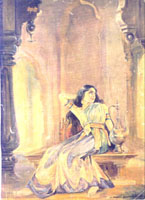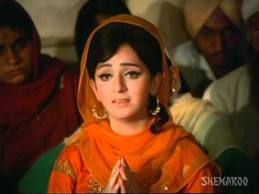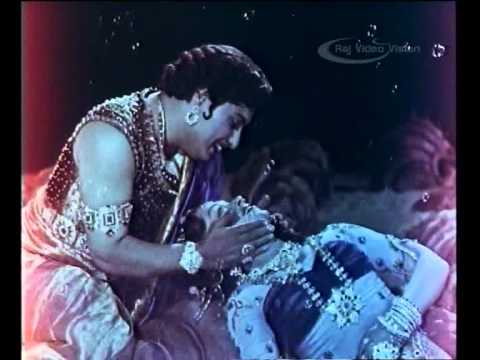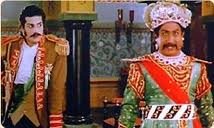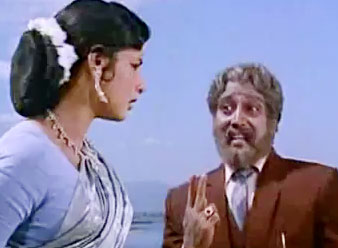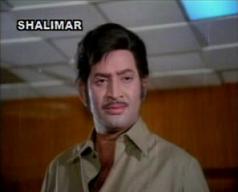Colour films in India
Readers can send additional information, corrections, photographs and even on their online archival encyclopædia only after its formal launch. |
India was the sixth country to have produced a colour film; at most seventh, if firmer dates about the first Soviet colour film indicate otherwise.
Contents |
Assamese
Shakuntala (1961/ dir: Dr. Bhupen Hazarika) was the first Assamese feature film with some sequences in colour. Assamese cinema has a B&W still, though.
The first colour film was Kamal Narayan Choudhury's Bhaity (1972).
'Ajali Nabou' (1980), directed by Nip Baruah, was the first Assamese film in Eastmancolour.
(No colour photographs are available in public from any of the three films. Can any reader help?)
Bengali
Kanchanjangha (Bengali: কাঞ্চনজঙ্ঘা Kanchonjônggha) (1962) written and directed by Satyajit Ray is arguably the first colour film in Bengali, Indian or East Pakistani. It was in Eastmancolour, which is more fragile than Technicolor. By the 1970s all complete colour prints of the film were lost and an international effort got together portions of the film available around them world, edited them together into a whole and restored the faded colours.
Gujarati
First Gujarat colour film: Liludi Dharti (1968). Director name Vallabh Chokshi
Hindi-Urdu
See the main entry Colour films in Hindi-Urdu
Prabhat Film Company's‘Sairandhri' (1933/ Hindi and Marathi versions/ dir: V. Shantaram) was the Indian first film to be shot in colour. However, the prints that were screened were in monochrome, apparently because of shoddy processing in Germany.
Ardersher Irani established India's first colour film processing studio in Bombay in 1937.
Kisan Kanya (lit: the peasant girl; 1937/ Dir: Moti B. Gidvani; prod. Ardeshir Irani) was arguably the first colour film in Hindi-Urdu, of India and of South Asia.
Kannada
‘Stree Ratna' (Kannada-1954) had some sequences in colour.
The first full-length colour film in Kannada, Amarashilpi Jakanachar [Jaggannachari], was released in 1964
Malayalam
‘Jeevitha Nauka' (1950) had one sequence in colour.
The first full-length Malayalam colour film was Kandam Vecha Coat (1961/ dir: T. R. Sundaram). It was produced by Modern Theatres, which had made the first Malayalam ‘talkie’ Balan (1938).
According to B. Vijayakumar, Kandam Vecha Coat was in Eastman colour and ‘was probably the first Malayalam film to use a movie trailer for the marketing of the film.’ (TheHindu, November 7, 2011)
Pakshiraja Studios’ Sabarimala Sree Ayyappan, (Gevacolor/ 1961), a mythological film, followed a few months later.
Udaya Studios’ Bharya (1962), Kadalamma (1963), Shakuntala (1965) and Pearl View (1970), some films from other studios, had a few sequences in colour.
Chemmeen (1967?), in full-length Eastmancolor, was a critical and commercial success. With music by Salil Chaudhary its songs were popular all over India. It won the President of India's Gold Medal for the best feature film in India.
The full-length colour films that followed were ‘Kallichellamma' (1969), ‘Nadhi,' ‘Kumaraambhavam' (1969), ‘Karakanakkadal' (1971), ‘Panitheeratha Veedu' (1972), ‘Nakhangal' (1973), ‘Chattakkari,' and ‘Nellu' (1974).
Manipuri
Langlen Thadoi (1984) by MA Singh (Maibam Amuthoi Singh) is the first colour feature film in Manipur produced by K.P Films International in 1984
(No photograph available. Can any reader help?)
Marathi
Sairandhri (1933), processed and printed in Germany; would have been the first colour film in Marathi, and also India's first colour film. However, its processing was not successful.
So, the question is, which was the second colour film in Marathi, because Sairandhri’s final, released print was not in colour.
Odiya/ Oriya
The first Oriya Colour Movie was "Gapa Helevi Sata" (1976) though 'Samaya' (1975) was partially coloured).
Punjabi
Indian Punjabi
Nanak Nam Jahaz Hai (Punjabi: ਨਾਨਕ ਨਾਮ ਜਹਾਜ਼ ਹੈ), a 1969 National Award winning Punjabi film directed by Ram Maheshwary, was the first Indian colour film in Punjabi.
Tamil
Haridas (Tamil-1944) and Naam Iruvar (Tamil-1947) had some sequences in colour.
The first Tamil film ‘entirely in colour’ was Alibabavum Narpadhu Thirudargalum-1956 (Geva Color)
Veerapandiya Kattabomman (1959) is said to be the second Tamil film to be shot in Technicolor; it was, like other Indian Technicolor films before and after, printed in London.
Which was the first? Well, Nadodi Mannan (1958) had a colour (reportedly Technicolor) sequence set on a tropical island.Its first half was in B/W but the second half in colour - in GevaColor. Therefore,Veerapandiya Kattabomman (1959) was the first Tamil film in Technicolor.
The first Eastmancolor movie in Tamil was the cheerful comedy Kathalikka Neramillai (We don't have any time for love; I1964), a hit.
Telugu
First ‘entirely in colour’ film Lavakusa (1963/ GevaColor).
First Eastmancolor film Eenadu (1982)
See also
CinemaScope films in Bangladesh, India, Nepal, Pakistan, Sri Lanka I.e. the first part of this article
70mm films in India/ South Asia
Cinerama theatres in India, Pakistan, Sri Lanka
Colour films in India




